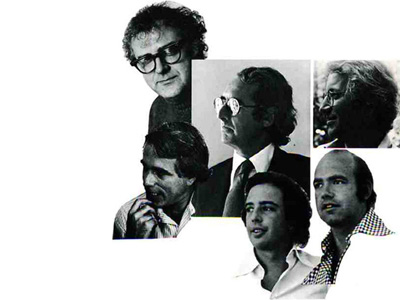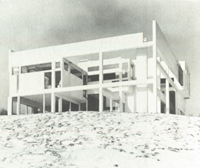You are in: Home page > Magazine Archive > The architecture between Whites and Grays

Emanuela Giudice
The architecture between Whites and Grays
Tools, methods and compositive applications
Abstract
The Twentieth century in architecture has experienced many episodes of intense debate. It is the century in which the 'discursive tools" increased through manifestos, essays, journals, schools, exhibitions. Thus, even more than in the previous centuries, the talk around architecture improved, overlapping at the same time the architecture itself with its forms and its construction. The word takes over and it can hide the architectural form to the scholar, unless this one does not use the design as a tool of analysis, true scientific and useful medium to reveal the architectural composition and its syntax, using the «compositive lectures».
Through figurative themes and architectural forms, this study challenges two dichotomous groups, the "Whites" and "Grays," which American architecture wanted to see as antagonists in reference to the architectural culture between the late 1960s and last 1980s. From the exhibition “The New York Five” organized by the MoMA in New York in 1969 to the Deconstructivism’s exegesis, the words are organized by discursive tools, from the magazines Oppositions and Perspecta to those that seem as real manifestos. Passing through the places in which the education of the architect can be rebuilt, the debate that elapsed between the "Whites" and "Grays" showed the need to re-establish, within the American culture, a discipline devoid of identity, making possible the return of a common research in which to reveal unexpected coincidences of compositional procedures and references.
Introduction
When in 1969 the Museum of Modern Art in New York calls together a handful of five architects, preparing the projects and bringing to the public the work of a hoped New York school, a critical discourse starts around the theoretical and building work of the five American architects [1]. Five Architects even before Whites, Peter Eisenman, John Hejduk, Richard Meier, Michael Graves and Charles Gwathmey are the protagonists of an architectural debate sealed, in the process, with the words of Arthur Drexler, Kenneth Frampton, Colin Rowe. And Philip Johnson too.
A few years earlier, in 1966, the same MoMA printed the "gentle manifesto" written by Robert Venturi, opening the door to a gray practice mixed of complexity and contradiction.
The architecture, no more immune to the profusion of discursive tools, would soon be found in the middle of an ideological debate, summarized in the image published by the magazine "A + U", where a revived Le Corbusier, preparing his “cenacolo”, placed himself at the center of the two groups[1]. The oppositions between Whites and Grays were not vacuous, as capable of creating contradictions, as in the language as in the architectural construction, through compositional procedures, just similar.
Associative methods Po-Mo.
Places. Saying the tools and methods used in architecture by Whites and Grays, it can look to those exposed along the "Strada Novissima" staged at the Venice Biennale in 1980. The magazine «Controspazio» prepared a special issue, reporting the reasons for a show in which recognize «not taking a distant position, closed drawing sitting in your studio, but [...] a postmodern urban ethics and a discursive and careful for the environment»[2].
At the “Corderie dell’Arsenale”, the Grays’ side appeared with the names of Charles Moore, Robert Venturi, Denise Scott Brown, in the words of Robert Stern and Vincent Scully plus a Michael Graves searching a compromise between the white and gray [2].
Emblem of associative procedures and in advance of the bricoleur bricoleur, the “Strada Novissima" designed by the Grays architects was being built on a reacquired freedom, between historical signs and meanings able to free the architectural form by the ideological dictates of the modernism.
In these designed facades, the elements of the story were so deformed, places out of scale, combined in an arbitrary manner, finding themself to work on the issues of representation and meaning in architecture, all to be rehabilitated.
Here was the vocabulary of architectural archetypes, the column, the pediment, the wall, the stair, starting to assume a metahistorical identity as a series of "invariants" of postmodern architecture to which the operations of the Grays are closely related [3]. Working on the classical language opens to the use of the fragment. Quote. Here is proclaimed the series of references and concepts of contiguity, similarity and contrast.
The Grays implemented the compositional techniques through assembly and relocation of signs taken from the architectural memory. In this way, the elements used in their architectures are mirrored in forms and meanings just made, partly in opposition to the Whites. It can be seen in the earliest work operations of Robert Venturi, in which the return to the Shingle Style and to the traditional American home had resolved in a typological reference reduced to a neorealistic sample. [4].
By the Whites, Michael Graves is the one that came close to what seemed antithetical, as Venturi has been for the Grays, implementing “mixed” compositional approaches. Through the project of small houses that look at the ballom frame building tradition, Graves has used empty walls, excavation shapes, thanks to the presence of a non-binding frame which became a metaphor. So, as a good bricoleur, Graves has blended the Shingle Style tradition to the Le Corbusier’s purism. If the entry becomes again ritual, as in the Hanselman House, on the opposite the Grays break the rule when, in the project for the Vanna Venturi House, Robert Venturi denies the entry, placing it not in line with the driveway. He also reaffirms the chimney, placing it over the axis of symmetr. Also the square window will become the connective element of the facade, when repeated, doubled and moved horizontally, it takes the shape of a "fenêtre en longeur".
Finally, the Grays have come to make a highly personal synthesis of the historical material, releasing for symbolic reasons, in new formal and typological contexts, rewritten by a common repertoire.
Self methods in total white
About ten years before the inauguration of the "Strada Novissima", the magazine «Casabella» published some Notes on conceptual architecture written by Peter Eisenman. The collaboration between the magazine directed by Mendini and the IAUS (Institute for Architectural and Urban Studies) - in which there were the best groups «to bounce, from the United States to Europe, the other issues alternative to the common design" - led to a reflection on conceptual understanding 'as a presence of mental dimension with the physical»[3].
The serial art, which proposed forms of geometric abstraction, would be replaced by “the object”, making the transition from an aesthetic, visual and sensitive experience to an intellectual one where text becomes the tool by which implementing the meaning. Often "damaged", the Whites’ texts list homes equipped with number (House I, House II, as in the case of Eisenman, House 10 as in the case of Hejduk) [5]. Displaced forms where the links between the elements seem to dissolve and where the reconstruction can only be given to the "reader", whose freedom of interpretation will be responsible for exploring new possibilities about the shape contributing to the creative process (and descriptive one). The Whites’ compositional actions referred to the structure’s topic, to antinaturalistic as (neo) rationalist grids, opposite to the real (and, of course, to the "genius loci"). [6]. In Eisenman’s design, as in Hejduk’s one it could be find the idea for which «the composition is architectural writing», in which the composition becomes «action, tool, procedure, to think, classify, develop and transform the own language» and where «the writing becomes more important than the work, writing is the work»[4].
The drawings in total white show rotations, oppositions, part of elementary forms, all held together by the program (rather than by function). But columns dressed up as pillar appear too - the House I designed by Eisenman in Princeton - entrances announced by partial "stylobates", opaque wood surfaces that wink to the traditional shingle style (the Smith House by Richard Meier).
After all, Whites’ architecture has references. Just, the difference lies in the reference to which the individual work refers: syntactic or iconic. The dispute between Whites and Grays seems able to attest on projects designed to "forms" and "figures", according to the definition given by Alan Colquhoun[5]. If the first assumes that the architectural forms can be reduced to an ahistorical zero degree[6], the last, going hand in hand with the end of the performance, it turns to the persuasion.
The architecture of the pop-Venturi side, the architecture parlante sailed alongside that of the white structuralists one or the architecure parlante de soi-même. And the tools, the methods and the compositional applications by the "Whites" and the "Grays" have been mixed with similar procedures [7] [8].
There are still some compositional ways, around that common issue that has been, for the Whites as for the Grays, the architectural design. It will be the warp, the deformed, the collapse and the implode, the proceeding that only few years later would have been collected under the Deconstructivism’s auspices.
[1] White and Gray. Eleven Modern American Architects, “A+U”, no. 52, April 1975.
[2] D’AMATO C., CELLINI F., La costruzione della Strada Novissima, D’AMATO C., CELLINI F. (eds.), La presenza del passato, “Controspazio”, January-December 1980, 10.
[3] MENDINI A., Editoriale, “Casabella”, no. 359-360, November-December 1971.
[4] LEONCILLI MASSI G., La composizione. Commentari, Marsilio, Venezia 1985, 20.
[5] COLQUHOUN A., Architettura moderna e storia, Laterza, Roma-Bari 1989, pp. 86-112.
[6] Ibidem, p. 125.
Emanuela Giudice is a Turin based educator. She graduated in architecture and she holds a PhD at the Polytechnic of Turin with the thesis “Lectures. Tools, methods and compositive applications in architecture between Whites and Grays”. She focuses her studies on the radical and post modern languages and their relationship with architecture and design. She collaborated with the Polytechnic of Turin and she has been lecturer at SJIU (Saint John International University).















